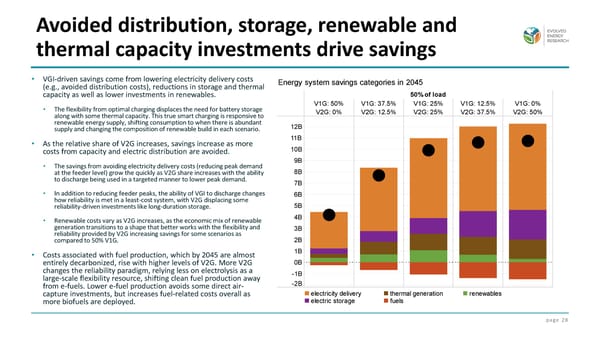page 28 • VGI-driven savings come from lowering electricity delivery costs (e.g., avoided distribution costs), reductions in storage and thermal capacity as well as lower investments in renewables. • The flexibility from optimal charging displaces the need for battery storage along with some thermal capacity. This true smart charging is responsive to renewable energy supply, shifting consumption to when there is abundant supply and changing the composition of renewable build in each scenario. • As the relative share of V2G increases, savings increase as more costs from capacity and electric distribution are avoided. • The savings from avoiding electricity delivery costs (reducing peak demand at the feeder level) grow the quickly as V2G share increases with the ability to discharge being used in a targeted manner to lower peak demand. • In addition to reducing feeder peaks, the ability of VGI to discharge changes how reliability is met in a least-cost system, with V2G displacing some reliability-driven investments like long-duration storage. • Renewable costs vary as V2G increases, as the economic mix of renewable generation transitions to a shape that better works with the flexibility and reliability provided by V2G increasing savings for some scenarios as compared to 50% V1G. • Costs associated with fuel production, which by 2045 are almost entirely decarbonized, rise with higher levels of V2G. More V2G changes the reliability paradigm, relying less on electrolysis as a large-scale flexibility resource, shifting clean fuel production away from e-fuels. Lower e-fuel production avoids some direct air- capture investments, but increases fuel-related costs overall as more biofuels are deployed. Avoided distribution, storage, renewable and thermal capacity investments drive savings
 Exploring the Value of Vehicle to Grid (V2G) for California Page 27 Page 29
Exploring the Value of Vehicle to Grid (V2G) for California Page 27 Page 29